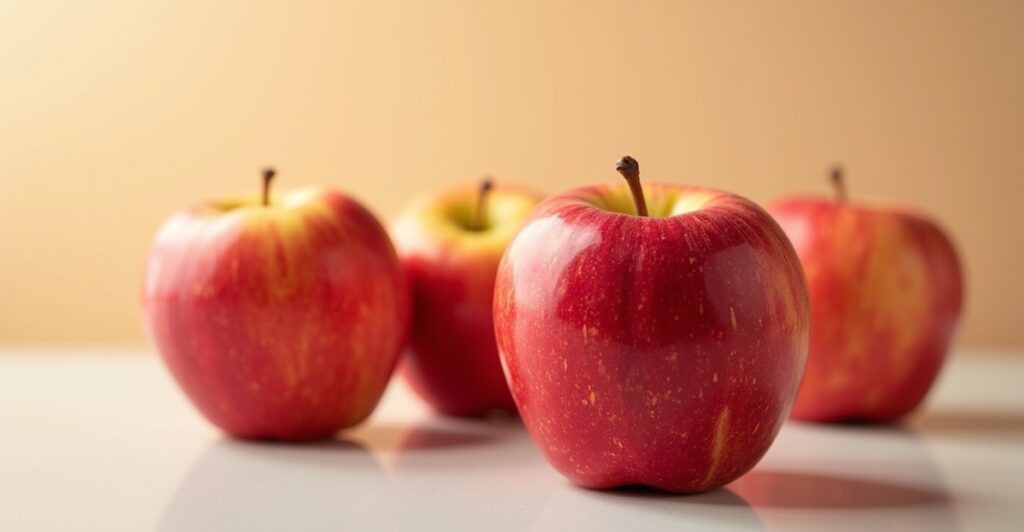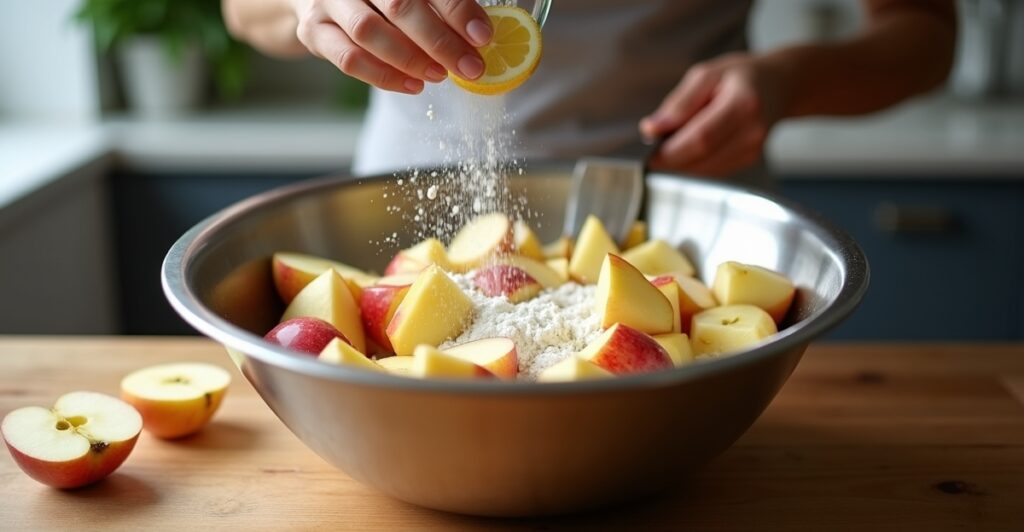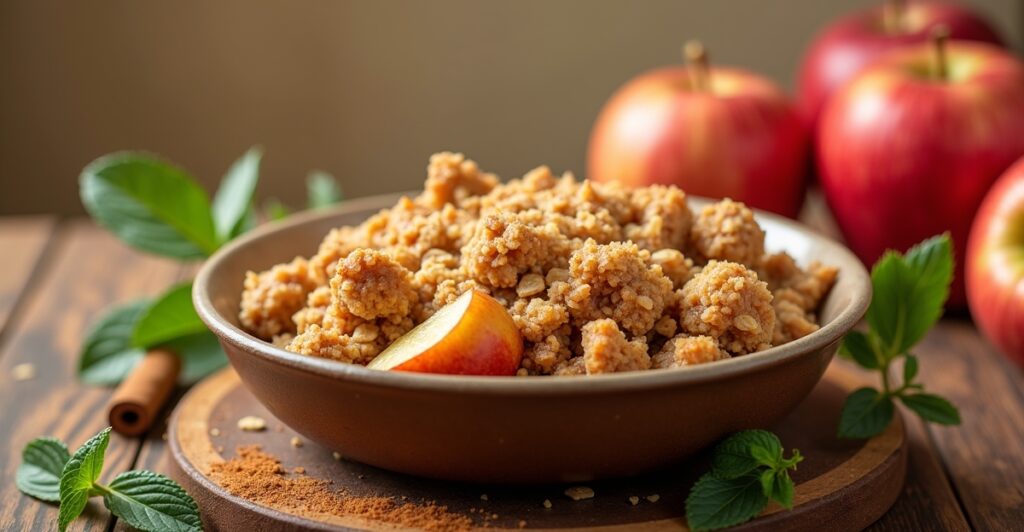Why Your Baked Apples Might Be Turning Mushy (And How to Fix It!)
There’s nothing more disappointing than slicing into a beautiful apple pie only to find a mushy, unidentifiable mess instead of tender, distinct apple pieces. If you’ve experienced this frustration, you’re not alone – it’s one of the most common baking challenges home cooks face.
The secret to avoiding mushy baked apples isn’t just about technique (though that matters too). The variety of apple you choose makes all the difference. Some apples are simply better suited for baking because of their natural structure, pectin content, and moisture levels.
In this guide, I’ll share the top 5 apple varieties that consistently hold their shape when baked, plus expert tips to ensure perfect results every time. Whether you’re making your first apple pie or you’re a seasoned baker looking to upgrade your apple game, this comprehensive guide will help you achieve those beautiful, tender-yet-firm apple pieces you’ve been dreaming of.
As someone who’s tested dozens of apple varieties in everything from simple baked apples to complex tarte tatin, I’ve learned that the right apple variety is your first line of defense against mushy results.
For more comprehensive insights into apple baking techniques, check out our Ultimate Guide to Baking with Apples.
Understanding Apple Anatomy for Baking Success
Before diving into our top 5 list, it’s helpful to understand why some apples turn to mush while others hold their shape beautifully when exposed to heat and moisture.
The key factors that determine how an apple behaves when baked are pectin content, flesh texture, and acidity levels. Apples with higher pectin content, firmer flesh, and balanced acidity are your best bets for maintaining structure during baking.
Quick Tip: Always select apples that feel firm and heavy for their size, as this often indicates good moisture content and density suitable for baking!
Understanding these fundamentals will help you make better choices not just from our top 5 list, but when exploring other apple varieties for your baking adventures. For broader guidance on selecting apples for different recipes, explore our guide on Choosing the Best Apple Varieties for Every Recipe.
The Role of Pectin: The Natural Structure Setter
Pectin is a natural gelling agent found in apple cell walls that acts like a glue, holding the fruit’s structure together even when heated. Apples with higher pectin content maintain their shape better because this natural polymer doesn’t break down as quickly during baking.
Think of pectin as your apple’s internal scaffolding – the stronger the scaffolding, the better the apple holds up under heat.
Flesh Texture: Firmness vs. Softness in the Oven
The initial firmness of an apple’s flesh directly correlates to its baking performance. Dense, crisp apples with tightly packed cells resist breaking down, while softer varieties with looser cellular structure tend to collapse and become mushy when heated.
This is why a crisp Granny Smith maintains its shape while a soft Red Delicious turns to sauce.
Acidity: The Flavor and Texture Balancer
Acidity plays a dual role in baking success. Higher acid content helps preserve the apple’s structure during cooking while also providing the tart balance that prevents overly sweet results. The acid helps maintain the pectin’s effectiveness and slows down enzymatic breakdown.
Fun Fact: Did you know that some apple varieties contain more pectin, a natural gelling agent, than others? This is key to why certain apples hold their shape better when baked!
The Top 5 Apples That Hold Their Shape When Baked
Here are the apple varieties that consistently deliver excellent results in baked goods, ranked by their overall performance and versatility:
[Schema Note: ItemList schema recommended for this numbered list]
#1: Granny Smith
The undisputed champion of baking apples, Granny Smith offers the perfect combination of tartness, firm texture, and high pectin content. These bright green apples maintain their shape exceptionally well and provide the ideal sweet-tart balance in desserts.
Their firm, dense flesh means you’ll get distinct, tender apple pieces that won’t disappear into mush, even after extended baking times. The natural tartness balances beautifully with added sugars and spices, making them perfect for pies, crumbles, and tarts.
In my experience, Granny Smiths are my absolute go-to for a perfectly tart and structurally sound apple pie. Their firm flesh means you get distinct, tender slices in every bite, never mush.
Best uses: Apple pie, apple crisp, tarte tatin, baked apples
For an in-depth comparison, read our Granny Smith vs. Honeycrisp: The Ultimate Showdown for Apple Pie.
#2: Honeycrisp
Despite their name suggesting they might be too crisp, Honeycrisp apples are exceptional for baking thanks to their dense cellular structure and balanced sweet-tart flavor. They hold their shape remarkably well while developing a tender texture that’s never mushy.
These apples bring natural sweetness that reduces the need for added sugar, while their crisp texture ensures beautiful, intact pieces in your finished desserts. I’ve found that even when baked for extended periods, Honeycrisp apples retain their delightful texture.
Best uses: Apple muffins, coffee cake, apple crisp, stuffed apples
Learn more about this versatile variety in our Granny Smith vs. Honeycrisp: The Ultimate Showdown for Apple Pie.

#3: Braeburn
Braeburn apples offer the perfect middle ground between sweet and tart with a firm texture that holds up beautifully to heat. Their complex flavor profile develops wonderfully during baking, becoming more nuanced and aromatic.
These New Zealand natives have dense flesh that softens to the perfect tender consistency without falling apart. Their balanced acidity makes them versatile for both sweet and savory applications.
Best uses: Apple galette, savory apple dishes, mixed apple desserts, apple bread
#4: Golden Delicious
Don’t let the name fool you – Golden Delicious are excellent baking apples with a mild sweetness and firm-yet-tender texture. While softer than Granny Smiths, they still maintain their structure well and offer a gentler flavor that works beautifully in delicate desserts.
Their naturally sweet flavor makes them perfect for recipes where you want apple flavor without excessive tartness. They pair exceptionally well with warm spices like cinnamon and nutmeg.
Best uses: Apple cake, muffins, gentle-flavored desserts, dishes for those who prefer milder apple taste
For comparison with other mild varieties, check out Why Gala Apples Are Perfect for Kid-Friendly Snacks and Mild Cakes.
#5: Pink Lady (Cripps Pink)
Pink Lady apples bring exceptional crispness and a distinctive sweet-tart flavor that intensifies beautifully when baked. Their firm, dense flesh holds its shape excellently while developing complex flavors during cooking.
These late-season apples have high acidity and natural sugars that create depth in baked goods. Their beautiful pink-blushed skin adds visual appeal to rustic desserts where peel is left on.
Best uses: Rustic apple tarts, apple crisps, mixed variety desserts, elegant presentations
Honorable Mentions & Apples to Use with Caution
While our top 5 are your safest bets, several other varieties can work well in specific situations, and some should be avoided entirely for structure-dependent recipes.
Apples That Hold Up Reasonably Well (but might soften slightly)
Fuji apples can work in baking applications, especially when you want extra sweetness, but they tend to soften more than our top picks. They’re best used in combinations with firmer varieties.
Gala apples offer mild flavor and reasonable structure for gentler baking applications like muffins or quick breads, though they’re not ideal for pies requiring distinct pieces.
Jonagold provides good flavor and decent structure, making it suitable for crumbles and crisps where some softening is acceptable.
Apples Best Reserved for Sauce or Combinations
McIntosh apples break down quickly when heated, making them excellent for applesauce but poor choices for pies or tarts where you want visible apple pieces.
Red Delicious should generally be avoided for baking as they become mealy and lose their shape completely, offering little flavor development during cooking.
Pro Tips: Ensuring Your Apples Bake Perfectly Every Time
Even with the right apple variety, proper preparation and technique are essential for perfect results. Here are my tried-and-tested methods for ensuring your apples maintain their shape and develop beautiful flavor:
[Schema Note: HowTo schema recommended for this step-by-step process]
Step 1: The Lemon Juice Trick (Browning & Acidity)
Always toss your sliced apples with fresh lemon juice immediately after cutting. This serves dual purposes: preventing browning and adding extra acidity that helps maintain structure during baking.
Use about 1 tablespoon of lemon juice per 4-5 apples. The acid not only preserves color but also reinforces the apples‘ natural pectin, helping them hold their shape even better.
Step 2: The Magic of Flour or Starch (Moisture Control)
Lightly dust your prepared apples with a small amount of flour, cornstarch, or tapioca starch before adding them to your recipe. This absorbs excess moisture released during baking and prevents watery, mushy results.
Use about 1-2 tablespoons of starch per 6 cups of sliced apples. This simple step makes an enormous difference in the final texture of your baked goods.

Step 3: Don’t Overcrowd or Overbake
Proper spacing and timing prevent overcooking, which can turn even the firmest apples mushy. Arrange apple pieces in a single layer when possible, and monitor your baking closely during the final stages.
Most apple desserts are done when the apples are tender but still hold their shape when pierced with a fork. They should yield slightly to pressure but not fall apart.
For more detailed troubleshooting guidance, visit our troubleshooting guide for watery apple pie filling.
Delicious Recipes Using the Best Baking Apples
Now that you know which apples to choose, put your knowledge to delicious use with these tried-and-tested recipes that showcase the beauty of properly selected baking apples:
Classic Apple Pie with [Recommended Apple]
Perfect your pie-making skills with our detailed guide to the secret to a flaky all-butter pie crust for your apple pie, featuring techniques that highlight the beautiful texture of properly chosen apples.
Perfectly Spiced Apple Crisp
Learn how to make perfect apple crisp with a crunchy oat topping that lets your carefully selected apples shine through.
Sweet & Tart Apple Muffins
Transform your favorite baking apples into tender, flavorful muffins that showcase their natural texture and taste.
Tender Apple & Coffee Cake
Create elegant coffee cakes where distinct apple pieces provide delightful texture contrast against tender crumb.
Baked Apples: Simple & Elegant Dessert
Try our classic baked apples with cinnamon and walnuts for a simple dessert that truly showcases apple variety.
Savory Pork Chops with Sautéed Apples
Explore savory applications with our 30-minute one-pan pork chops with apples and onions, where firm apples provide perfect textural contrast.

Ready to start baking? Choose your favorite recipe and experience the difference that the right apple variety makes!
Frequently Asked Questions (FAQs)
[Schema Note: FAQPage schema recommended for this Q&A section]
Why do some apples get mushy when baked?
Apples turn mushy when their cellular structure breaks down due to low pectin content, soft flesh, or overcooking. Varieties with dense flesh and high pectin maintain their shape better.
What is the best apple for baking pies?
Granny Smith apples are considered the gold standard for pie baking due to their firm texture, high pectin content, and perfect sweet-tart balance that holds up during extended baking.
Which apples hold their shape when baked?
The top varieties for maintaining shape are Granny Smith, Honeycrisp, Braeburn, Golden Delicious, and Pink Lady, all of which have firm flesh and good structural integrity.
Can Fuji apples be used for baking?
Fuji apples can be used for baking but tend to soften more than ideal varieties. They work best in quick breads, muffins, or when combined with firmer apple varieties.
Find Your Perfect Baking Apple!
Armed with this knowledge of the top 5 apples that won’t turn to mush when baked, you’re ready to create beautiful desserts with perfectly textured apple pieces every time. Remember: start with the right variety, prep them properly, and watch your baking transform.
Which of these apple varieties will you try first? Share your favorite baking apples in the comments below!